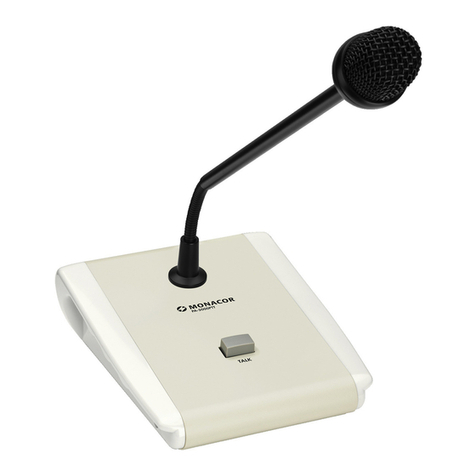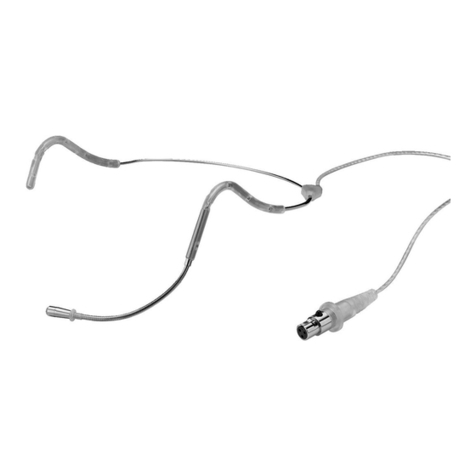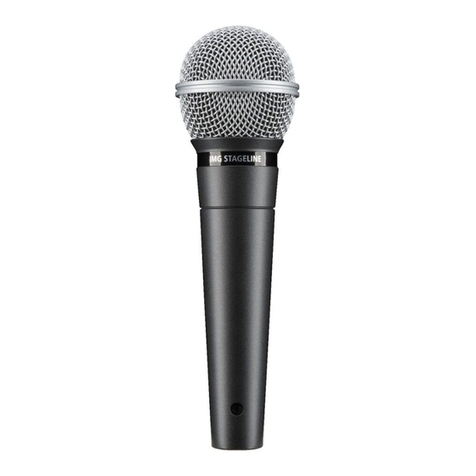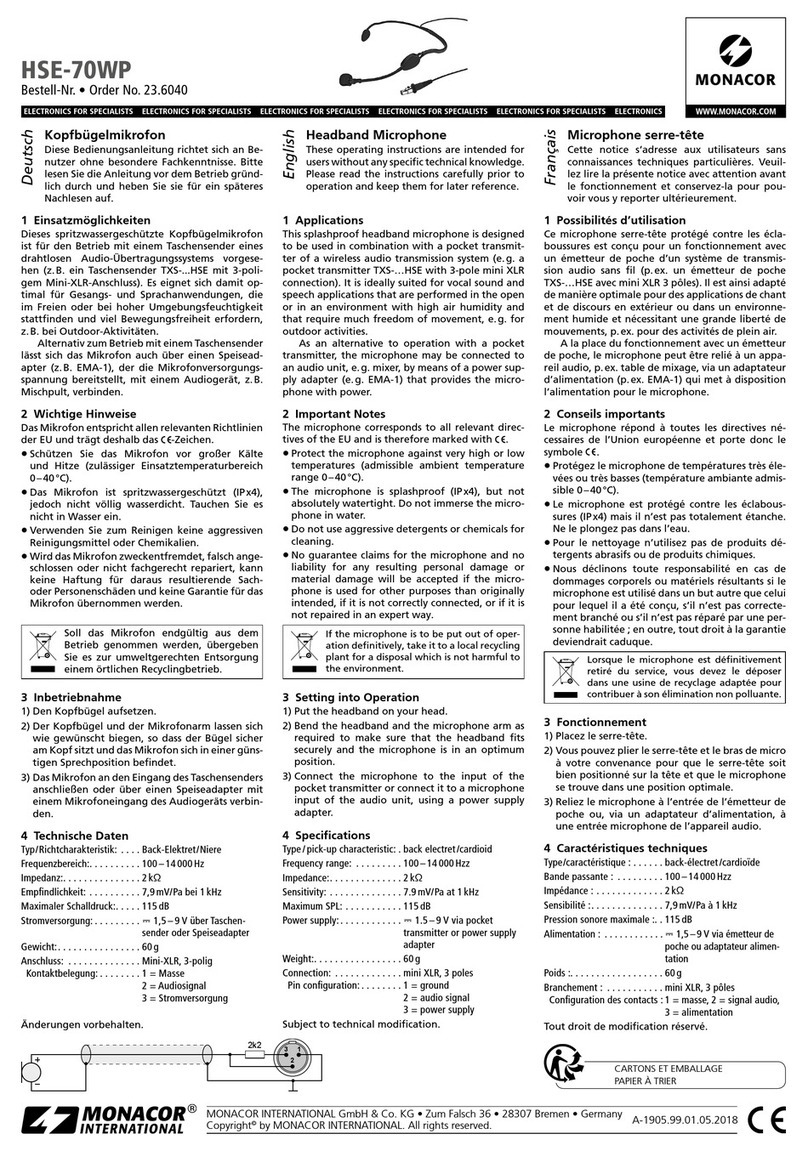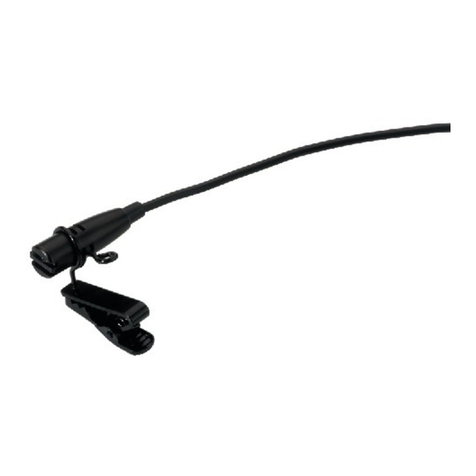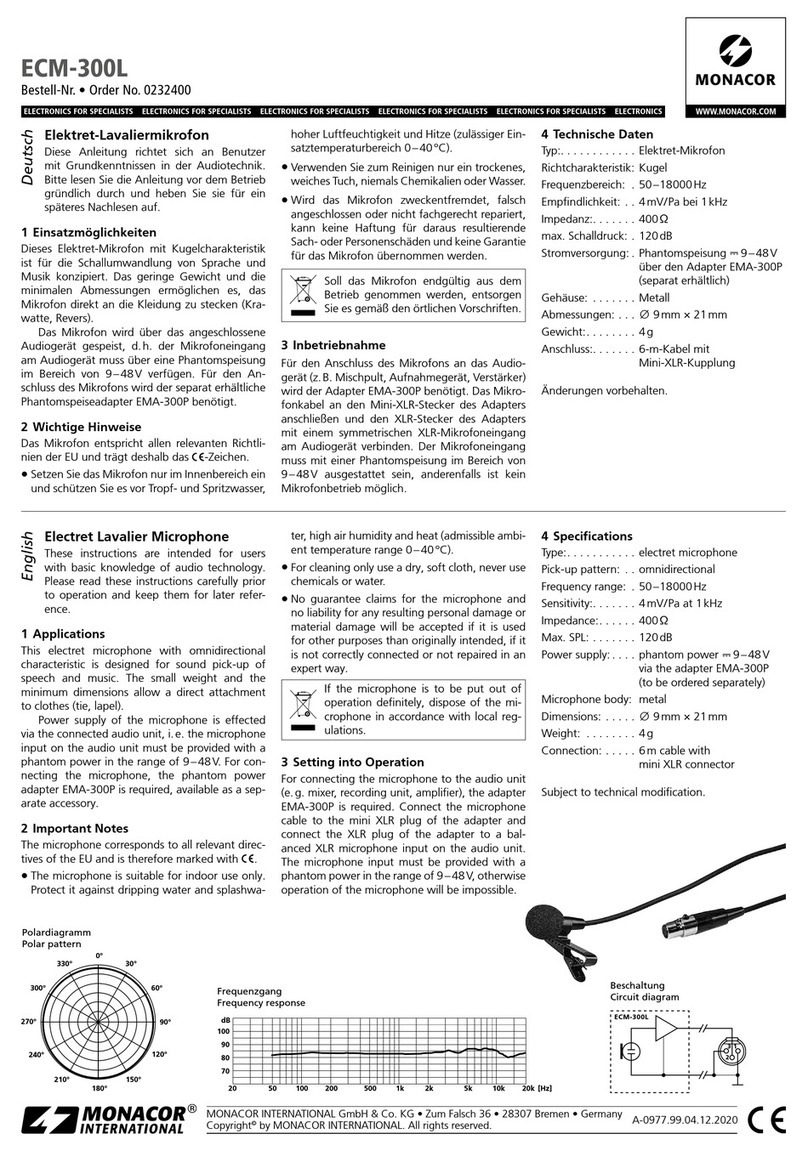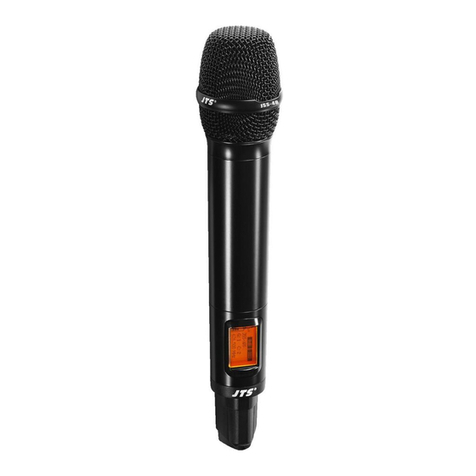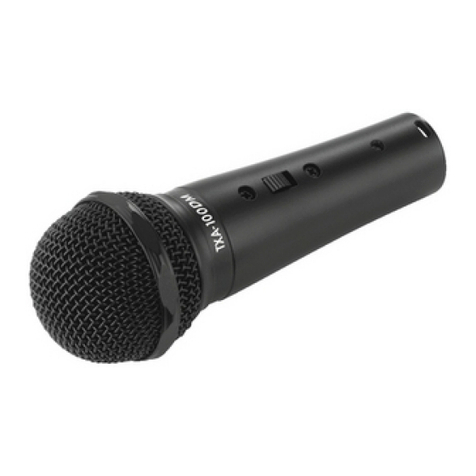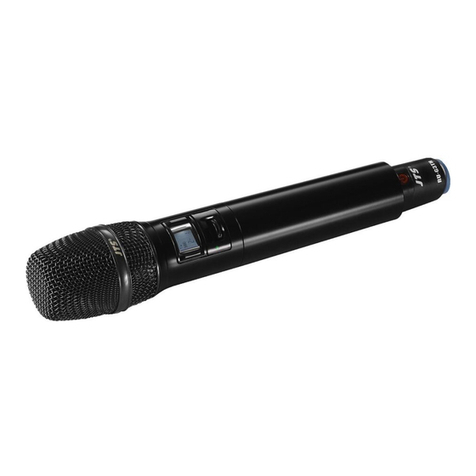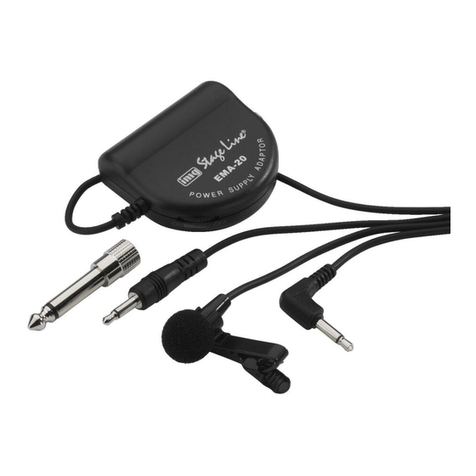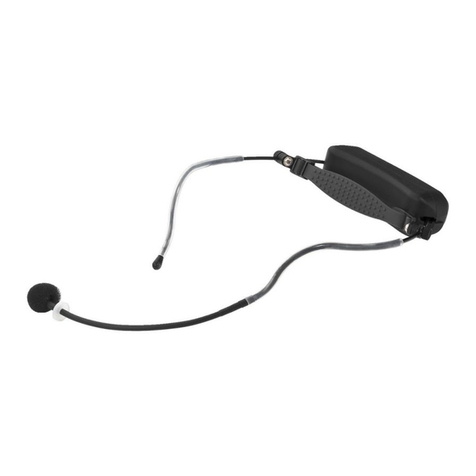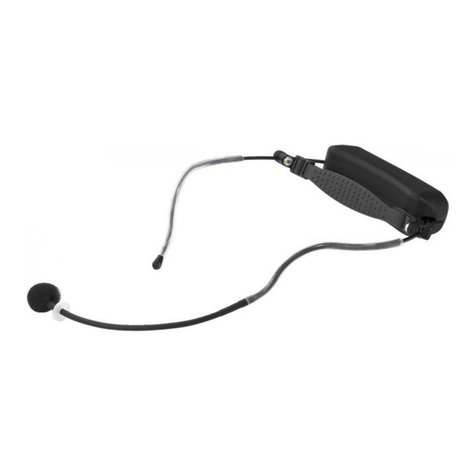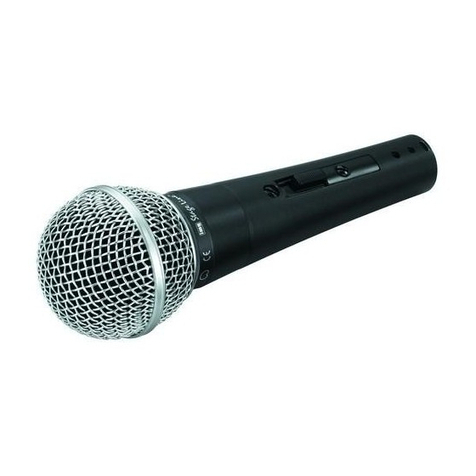
wwwwww..iimmggssttaaggeelliinnee..ccoomm
Copyright©by MONACOR INTERNATIONAL GmbH & Co. KG, Bremen, Germany. All rights reserved. A-0397.99.01.03.2005
®
Kopfbügel-Mikrofon
1Einsatzmöglichkeiten
Das Kopfbügel-Mikrofon HSE-90 eignet sich opti-
mal für Gesangs- und Sprachanwendungen, die
viel Bewegungsfreiheit erfordern. Für den Betrieb
wird zusätzlich ein Speiseadapter (z. B. EMA-1,
EMA-2, EMA-40, EMA-300P) oder zur drahtlosen
Tonübertragung ein Taschensender (TXS-...HSE)
von „img Stage Line“ benötigt.
2Hinweise für den sicheren Gebrauch
Das Mikrofon entspricht der EU-Richtlinie für elek-
tromagnetische Verträglichkeit 89/336/EWG.
●Setzen Sie das Mikrofon nur im Innenbereich
ein und schützen Sie es vor Tropf- und Spritz-
wasser, hoher Luftfeuchtigkeit und Hitze (zuläs-
siger Einsatztemperaturbereich 0 – 40 °C).
●Verwenden Sie für die Reinigung nur ein trocke-
nes, weiches Tuch, niemals Chemikalien oder
Wasser.
●Wird das Mikrofon zweckentfremdet, falsch
angeschlossen oder nicht fachgerecht repariert,
kann keine Haftung für daraus resultierende
Sach- oder Personenschäden und keine Ga-
rantie für das Mikrofon übernommen werden.
3Inbetriebnahme
1) Das Kopfbügelmikrofon aufsetzen und die
Mikrofonkapsel dicht vor dem Mund in eine
günstige Sprechposition bringen. Dazu lässt
sich der Mikrofonarm in alle Richtungen bie-
gen.
2) Die Mini-XLR-Kupplung des Mikrofonkabels in
die Eingangsbuchse des Taschensenders oder
des Speiseadapters stecken. Bei Verwendung
eines Speiseadapters diesen an den Mikrofon-
eingang eines Audiogerätes anschließen.
Soll das Mikrofon endgültig aus dem
Betrieb genommen werden, überge-
ben Sie es zur umweltgerechten Ent-
sorgung einem örtlichen Recycling-
betrieb.
4Technische Daten
Mikrofontyp: . . . . . . . . . Back-Elektret
Richtcharakteristik: . . . . Niere
Frequenzbereich: . . . . . 20 – 20 000 Hz
Impedanz: . . . . . . . . . . . 650 Ω
Empfindlichkeit: . . . . . . . 10 mV/Pa bei 1 kHz
Maximaler Schalldruck: . 120 dB
Stromversorgung: . . . . . 1,5 – 9 V über
Speiseadapter oder
Taschensender
Gewicht: . . . . . . . . . . . . 25 g
Anschluss: . . . . . . . . . . . 1-m-Kabel mit 3-pol.
Mini-XLR-Kupplung
1 = Masse
2 = Audiosignal
3 = Stromversorgung
Änderungen vorbehalten.
2
31
Headband Microphone
1Applications
The headband microphone HSE-90 is ideally
suited for vocal sound and speech applications
which require much freedom of movement. For
the operation, additionally a power supply adapter
(e. g. EMA-1, EMA-2, EMA-40, EMA-300P) or for
wireless audio transmission a pocket transmitter
(TXS-...HSE) from “img Stage Line” is required.
2Safety Notes
The microphone corresponds to the directive for
electromagnetic compatibility 89/336/EEC.
●The microphone is suitable for indoor use only.
Protect it against dripping water and splash
water, high air humidity, and heat (admissible
ambient temperature range 0 – 40 °C).
●For cleaning only use a dry, soft cloth, by no
means chemicals or water.
●No guarantee claims for the microphone or lia-
bility for any resulting personal damage or ma-
terial damage will be accepted if the micro-
phone is used for other purposes than originally
intended, if it is not correctly connected, or not
repaired in an expert way.
3Setting into Operation
1) Put on the headband microphone and place the
microphone cartridge close to the mouth into a
favourable talk position. For this purpose the
microphone arm can be moved in all directions.
2) Connect the mini XLR inline jack of the micro-
phone cable to the input jack of the pocket
transmitter or power supply adapter. When
using a power supply adapter, connect it to the
microphone input of an audio unit.
If the microphone is to be put out of
operation definitively, take it to a local
recycling plant for a disposal which is
not harmful to the environment.
4Specifications
Microphone type: . . . . . back electret
Pick-up characteristic: . . cardioid
Frequency range: . . . . . 20 – 20 000 Hz
Impedance: . . . . . . . . . . 650 Ω
Sensitivity: . . . . . . . . . . . 10 mV/Pa at 1 kHz
SPL max.: . . . . . . . . . . . 120 dB
Power supply: . . . . . . . . 1.5 – 9 V via power
supply adapter or
pocket transmitter
Weight: . . . . . . . . . . . . . 25 g
Connection: . . . . . . . . . . 1 m cable with 3-pole
mini XLR inline jack
1 = ground
2 = audio signal
3 = power supply
Subject to technical modification.
2
31
HSE-90
Best.-Nr. 23.4070
GB
D A CH
Microphone serre-tête
1Possibilités d’utilisation
Le microphone serre-tête HSE-90, est idéalement
adapté pour des applications de discours et de
chant requérant une grande liberté de mouve-
ments. Pour le fonctionnement, un adaptateur
d’alimentation (p. ex. EMA-1, EMA-2, EMA-40 ou
EMA-300P) ou un émetteur de poche (TXS-
…HSE) de “img Stage Line” pour la transmission
audio sans fil est en plus nécessaire.
2Conseils d’utilisation et de sécurité
Le microphone répond à la norme européenne
89/336/CEE, relative à la compatibilité électro-
magnétique.
●Le microphone n’est conçu que pour une utilisa-
tion en intérieur. Protégez-le de tout type de pro-
jections d’eau, des éclaboussures, d’une humi-
dité élevée et de la chaleur (plage de température
de fonctionnement autorisée : 0 – 40°C).
●Pour le nettoyer, utilisez uniquement un chiffon
sec et doux, en aucun cas de produits chimi-
ques ou d’eau.
●Nous déclinons toute responsabilité en cas de
dommages matériels ou corporels résultants si
le microphone est utilisé dans un but autre que
celui pour lequel il a été conçu, s’il n’est pas cor-
rectement branché ou s’il n’est pas réparé par
une personne habilitée ; en outre, la garantie
deviendrait caduque.
3Fonctionnement
1) Mettez le microphone serre-tête et positionnez
la capsule micro près de la bouche dans une
position favorable pour parler. Pour ce faire, le
bras de micro peut être bougé dans toutes les
directions.
2) Reliez la fiche mini XLR du cordon micro à la
prise d’entrée de l’émetteur de poche ou de
l’adaptateur d’alimentation. Si vous utilisez un
adaptateur d’alimentation, reliez-le à une en-
trée micro d’un appareil audio.
Lorsque le microphone est définitive-
ment retiré du service, vous devez le
déposer dans une usine de recyclage
adaptée pour contribuer à son élimi-
nation non polluante.
4Caractéristiques techniques
Type : . . . . . . . . . . . . . . back électret
Caractéristique : . . . . . . cardioïde
Bande passante : . . . . . 20 – 20 000 Hz
Impédance : . . . . . . . . . 650 Ω
Sensibilité : . . . . . . . . . . 10 mV/Pa/1 kHz
Pression sonore
maximale : . . . . . . . . . . . 120 dB
Alimentation : . . . . . . . . 1,5 – 9 V par adapta-
teur alimentation ou
émetteur de poche
Poids : . . . . . . . . . . . . . . 25 g
Branchement : . . . . . . . . cordon 1 m de long
avec mini XLR femelle
3 pôles
1 = masse
2 = signal audio
3 = alimentation
Tout droit de modification réservé.
2
31
